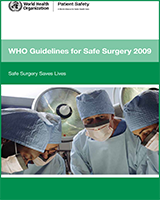Adult and paediatric self-inflating breathing bags with masks Foot-powered suction Stethoscope, sphygmomanometer, thermometer Pulse oximeter Oxygen concentrator or tank oxygen and a drawover vaporizer with hoses Laryngoscopes, bougies
| Complete anaesthesia, resuscitation and airway management systems including:
Reliable oxygen sources Vaporizer(s) Hoses and valves Bellows or bag to inflate lungs Face masks (sizes 00–5) Work surface and storage Paediatric anaesthesia system Oxygen supply failure alarm; oxygen analyser Adult and paediatric resuscitator sets Pulse oximeter, spare probes, adult and paediatric *Defibrillator (one per operating suite or intensive care unit) *Electrocardiograph monitor *Laryngoscope, Macintosh blades 1–3( 4) Oxygen concentrator(s) (cylinder) Foot or electric suction Intravenous pressure infusor bag Adult and paediatric resuscitator sets Magill forceps (adult and child), intubation stylet or bougie Spinal needles 25G Nerve stimulator Automatic non-invasive blood pressure monitor
| Same as level 2 with these additions (per each per operating room or intensive care unit bed, except where stated):
Electrocardiograph monitor *Anaesthesia ventilator, reliable electric power source with manual override Infusion pumps (two per bed) Pressure bag for intravenous infusion Electric or pneumatic suction Thermometer (temperature probe *) Electric warming blanket Electric overhead heater Infant incubator Laryngeal mask, airways sizes 2, 3, 4 (three sets per operating room) Intubating bougies, adult and child (one set per operating room) Anaesthetic agent (gas and vapour) analyser Depth of anaesthesia monitors are being increasingly recommended for cases at high risk of awareness but are not standard in many countries.
|
